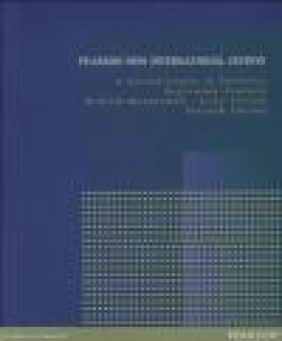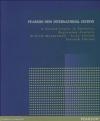A Second Course in Statistics
Terry Sincich, William Mendenhall
A Second Course in Statistics
Terry Sincich, William Mendenhall
- Producent: Pearson
- Rok produkcji: 2013
- ISBN: 9781292042909
- Ilość stron: 752
Niedostępna
Opis: A Second Course in Statistics - Terry Sincich, William Mendenhall
The Second Course in Statistics is an increasingly important offering since more students are arriving at college having taken AP Statistics in high school. Mendenhall/Sincich's A Second Course in Statistics is the perfect book for courses that build on the knowledge students gain in AP Statistics, or the freshman Introductory Statistics course. A Second Course in Statistics: Regression Analysis, Seventh Edition, focuses on building linear statistical models and developing skills for implementing regression analysis in real situations. This text offers applications for engineering, sociology, psychology, science, and business. The authors use real data and scenarios extracted from news articles, journals, and actual consulting problems to show how to apply the concepts. In addition, seven case studies, now located throughout the text after applicable chapters, invite students to focus on specific problems, and are suitable for class discussion.1. A Review of Basic Concepts (Optional) 1.1 Statistics and Data 1.2 Populations, Samples, and Random Sampling 1.3 Describing Qualitative Data 1.4 Describing Quantitative Data Graphically 1.5 Describing Quantitative Data Numerically 1.6 The Normal Probability Distribution 1.7 Sampling Distributions and the Central Limit Theorem 1.8 Estimating a Population Mean 1.9 Testing a Hypothesis About a Population Mean 1.10 Inferences About the Difference Between Two Population Means 1.11 Comparing Two Population Variances 2. Introduction to Regression Analysis 2.1 Modeling a Response 2.2 Overview of Regression Analysis 2.3 Regression Applications 2.4 Collecting the Data for Regression 3. Simple Linear Regression 3.1 Introduction 3.2 The Straight-Line Probabilistic Model 3.3 Fitting the Model: The Method of Least Squares 3.4 Model Assumptions 3.5 An Estimator of s2 3.6 Assessing the Utility of the Model: Making Inferences About the Slope ss1 3.7 The Coefficient of Correlation 3.8 The Coefficient of Determination 3.9 Using the Model for Estimation and Prediction 3.10 A Complete Example 3.11 Regression Through the Origin (Optional) Case Study 1: Legal Advertising--Does It Pay? 4. Multiple Regression Models 4.1 General Form of a Multiple Regression Model 4.2 Model Assumptions 4.3 A First-Order Model with Quantitative Predictors 4.4 Fitting the Model: The Method of Least Squares 4.5 Estimation of s2, the Variance of e 4.6 Testing the Utility of a Model: The Analysis of Variance F-Test 4.7 Inferences About the Individual ss Parameters 4.8 Multiple Coefficients of Determination: R2 and R2adj 4.9 Using the Model for Estimation and Prediction 4.10 An Interaction Model with Quantitative Predictors 4.11 A Quadratic (Second-Order) Model with a Quantitative Predictor 4.12 More Complex Multiple Regression Models (Optional) 4.13 A Test for Comparing Nested Models 4.14 A Complete Example Case Study 2: Modeling the Sale Prices of Residential Properties in Four Neighborhoods 5. Principles of Model Building 5.1 Introduction: Why Model Building is Important 5.2 The Two Types of Independent Variables: Quantitative and Qualitative 5.3 Models with a Single Quantitative Independent Variable 5.4 First-Order Models with Two or More Quantitative Independent Variables 5.5 Second-Order Models with Two or More Quantitative Independent Variables 5.6 Coding Quantitative Independent Variables (Optional) 5.7 Models with One Qualitative Independent Variable 5.8 Models with Two Qualitative Independent Variables 5.9 Models with Three or More Qualitative Independent Variables 5.10 Models with Both Quantitative and Qualitative Independent Variables 5.11 External Model Validation 6. Variable Screening Methods 6.1 Introduction: Why Use a Variable-Screening Method? 6.2 Stepwise Regression 6.3 All-Possible-Regressions Selection Procedure 6.4 Caveats Case Study 3: Deregulation of the Intrastate Trucking Industry 7. Some Regression Pitfalls 7.1 Introduction 7.2 Observational Data Versus Designed Experiments 7.3 Parameter Estimability and Interpretation 7.4 Multicollinearity 7.5 Extrapolation: Predicting Outside the Experimental Region 7.6 Variable Transformations 8. Residual Analysis 8.1 Introduction 8.2 Plotting Residuals 8.3 Detecting Lack of Fit 8.4 Detecting Unequal Variances 8.5 Checking the Normality Assumption 8.6 Detecting Outliers and Identifying Influential Observations 8.7 Detection of Residual Correlation: The Durbin-Watson Test Case Study 4: An Analysis of Rain Levels in California Case Study 5: An Investigation of Factors Affecting the Sale Price of Condominium Units Sold at Public Auction 9. Special Topics in Regression (Optional) 9.1 Introduction 9.2 Piecewise Linear Regression 9.3 Inverse Prediction 9.4 Weighted Least Squares 9.5 Modeling Qualitative Dependent Variables 9.6 Logistic Regression 9.7 Ridge Regression 9.8 Robust Regression 9.9 Nonparametric Regression Models 10. Introduction to Time Series Modeling and Forecasting 10.1 What is a Time Series? 10.2 Time Series Components 10.3 Forecasting Using Smoothing Techniques (Optional) 10.4 Forecasting: The Regression Approach 10.5 Autocorrelation and Autoregressive Error Models 10.6 Other Models for Autocorrelated Errors (Optional) 10.7 Constructing Time Series Models 10.8 Fitting Time Series Models with Autoregressive Errors 10.9 Forecasting with Time Series Autoregressive Models 10.10 Seasonal Time Series Models: An Example 10.11 Forecasting Using Lagged Values of the Dependent Variable (Optional) Case Study 6: Modeling Daily Peak Electricity Demands 11. Principles of Experimental Design 11.1 Introduction 11.2 Experimental Design Terminology 11.3 Controlling the Information in an Experiment 11.4 Noise-Reducing Designs 11.5 Volume-Increasing Designs 11.6 Selecting the Sample Size 11.7 The Importance of Randomization 12. The Analysis of Variance for Designed Experiments 12.1 Introduction 12.2 The Logic Behind an Analysis of Variance 12.3 One-Factor Completely Randomized Designs 12.4 Randomized Block Designs 12.5 Two-Factor Factorial Experiments 12.6 More Complex Factorial Designs (Optional) 12.7 Follow-Up Analysis: Tukey's Multiple Comparisons of Means 12.8 Other Multiple Comparisons Methods (Optional) 12.9 Checking ANOVA Assumptions Case Study 7: Reluctance to Transmit Bad News: The MUM Effect Appendix A: Derivation of the Least Squares Estimates of ss0 and ss1 in Simple Linear Regression Appendix B: The Mechanics of a Multiple Regression Analysis B.1 Introduction B.2 Matrices and Matrix Multiplication B.3 Identity Matrices and Matrix Inversion B.4 Solving Systems of Simultaneous Linear Equations B.5 The Least Squares Equations and Their Solution B.6 Calculating SSE and s2 B.7 Standard Errors of Estimators, Test Statistics, and Confidence Intervals for ss0, ss1, ... , ssk B.8 A Confidence Interval for a Linear Function of the ss Parameters; A Confidence Interval for E(y) B.9 A Prediction Interval for Some Value of y to be Observed in the Future Appendix C: A Procedure for Inverting a Matrix Appendix D: Statistical Tables Table D.1: Normal Curve Areas Table D.2: Critical Values for Student's t Table D.3: Critical Values for the F Statistic: F.10 Table D.4: Critical Values for the F Statistic: F.05 Table D.5: Critical Values for the F Statistic: F.025 Table D.6: Critical Values for the F Statistic: F.01 Table D.7: Random Numbers Table D.8: Critical Values for the Durbin-Watson d Statistic (a =.05) Table D.9: Critical Values for the Durbin-Watson d Statistic (a =.01) Table D.10: Critical Values for the X2-Statistic Table D.11: Percentage Points of the Studentized Range, q(p,v), Upper 5% Table D.12: Percentage Points of the Studentized Range, q(p,v), Upper 1% Appendix E: File Layouts for Case Study Data Sets Answers to Selected Odd Numbered Exercises Index Technology Tutorials: SAS, SPSS, MINITAB, and R (on CD)
Producent:
GPSR Pearson Central Europe Sp. z o.o.
ul. Szamocka 8
01-748 Warszawa (PL)
tel: 459 596 060
email: [email protected]
Szczegóły: A Second Course in Statistics - Terry Sincich, William Mendenhall
Tytuł: A Second Course in Statistics
Autor: Terry Sincich, William Mendenhall
Producent: Pearson
ISBN: 9781292042909
Rok produkcji: 2013
Ilość stron: 752
Waga: 1.6 kg






























